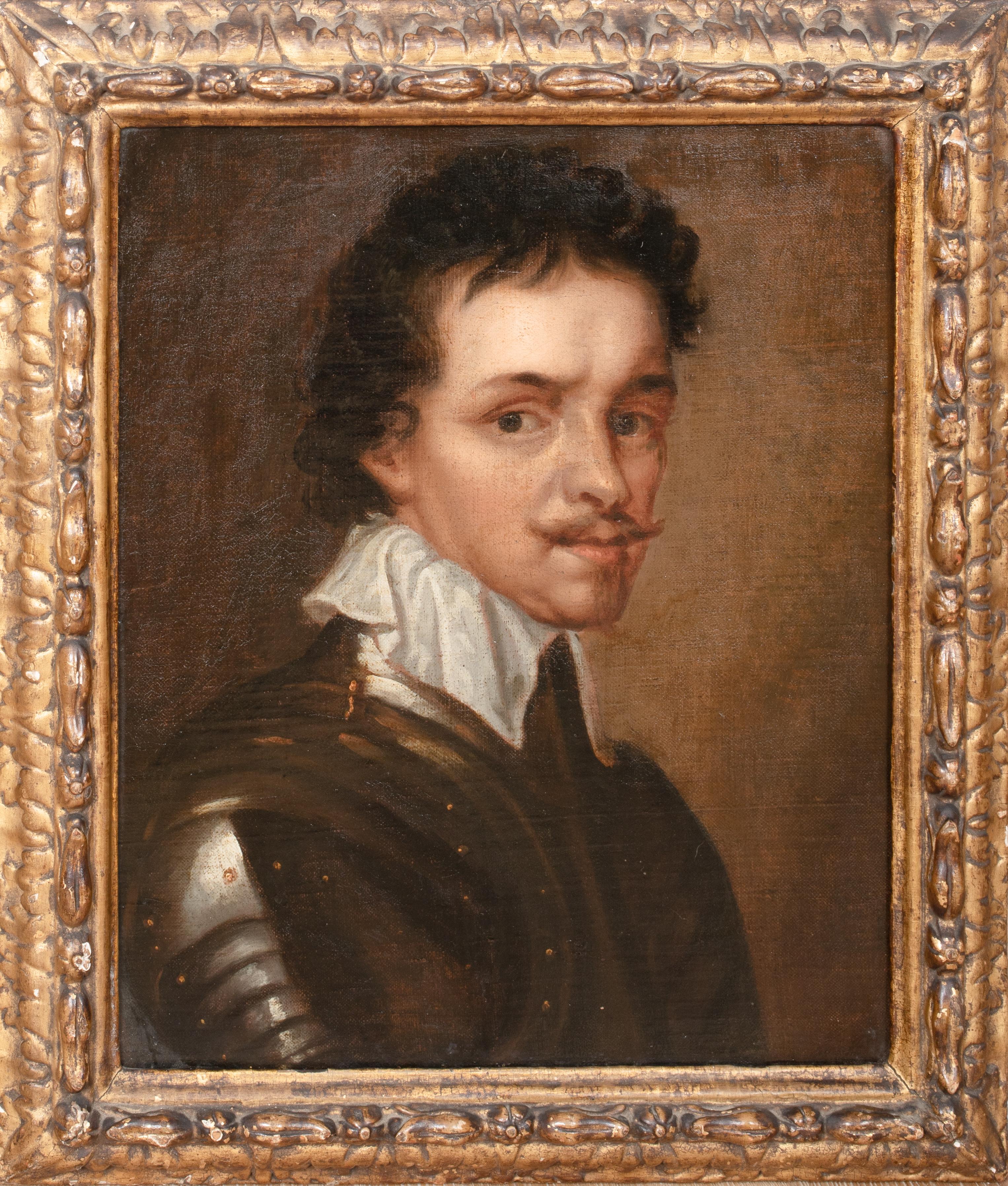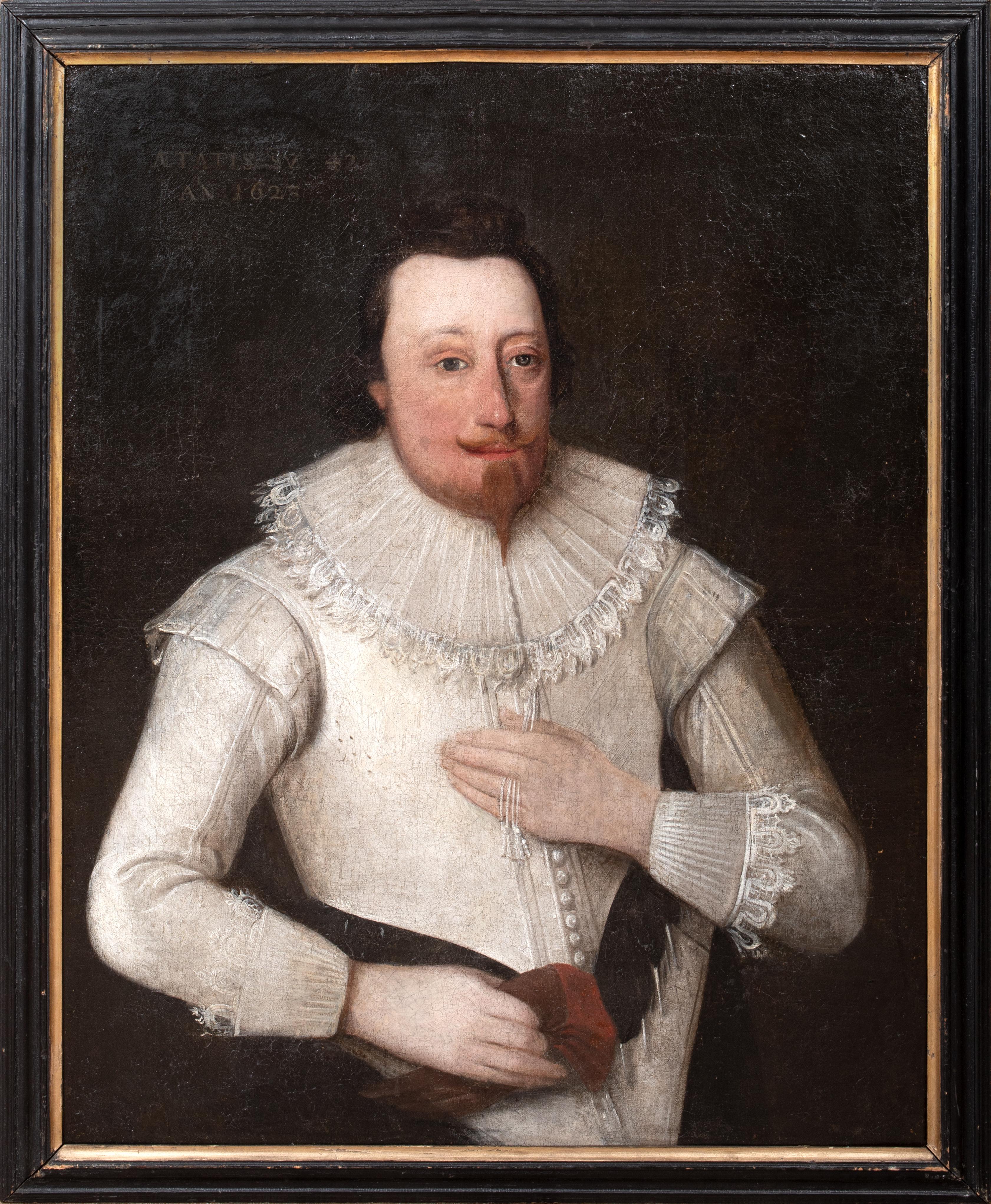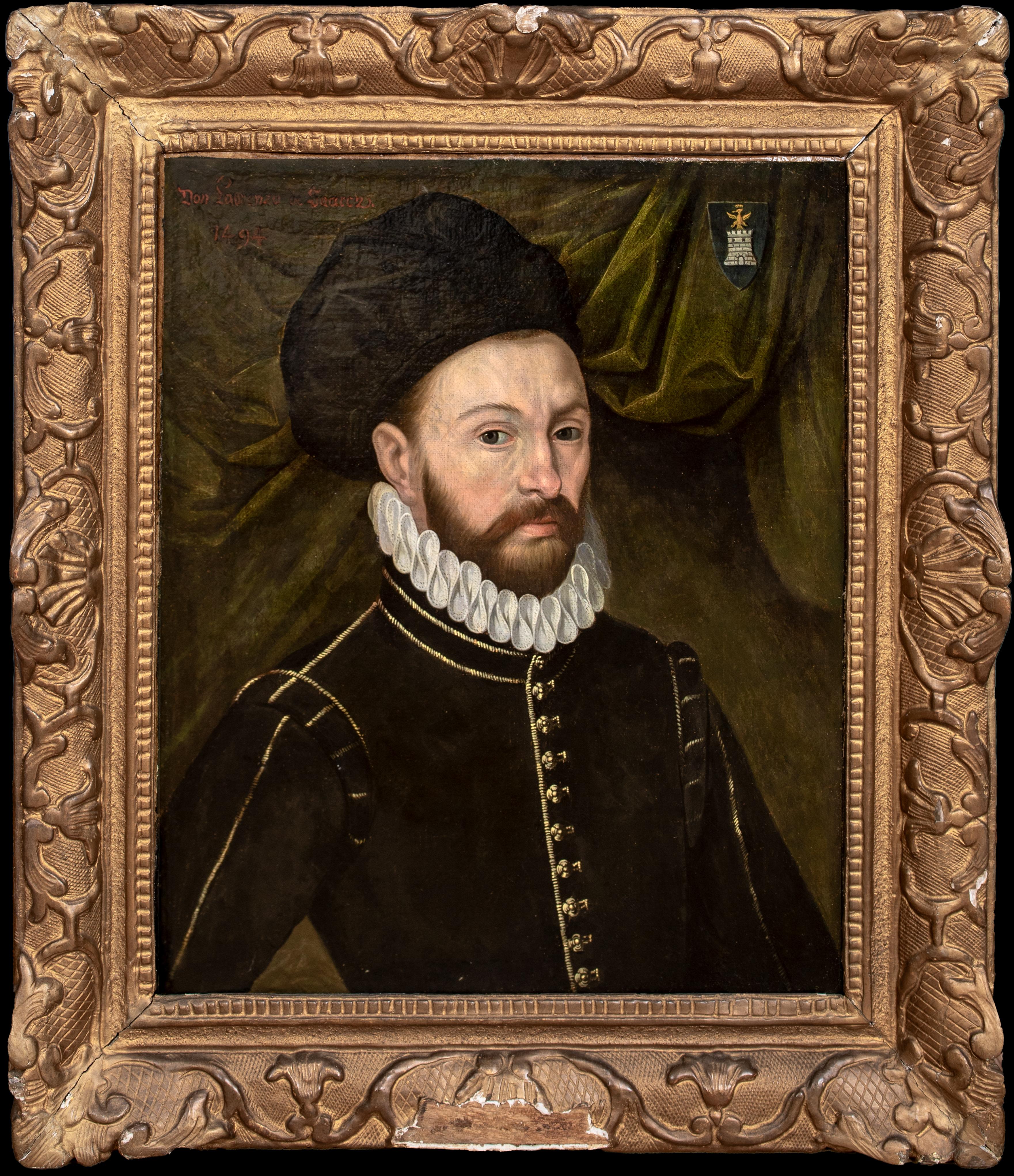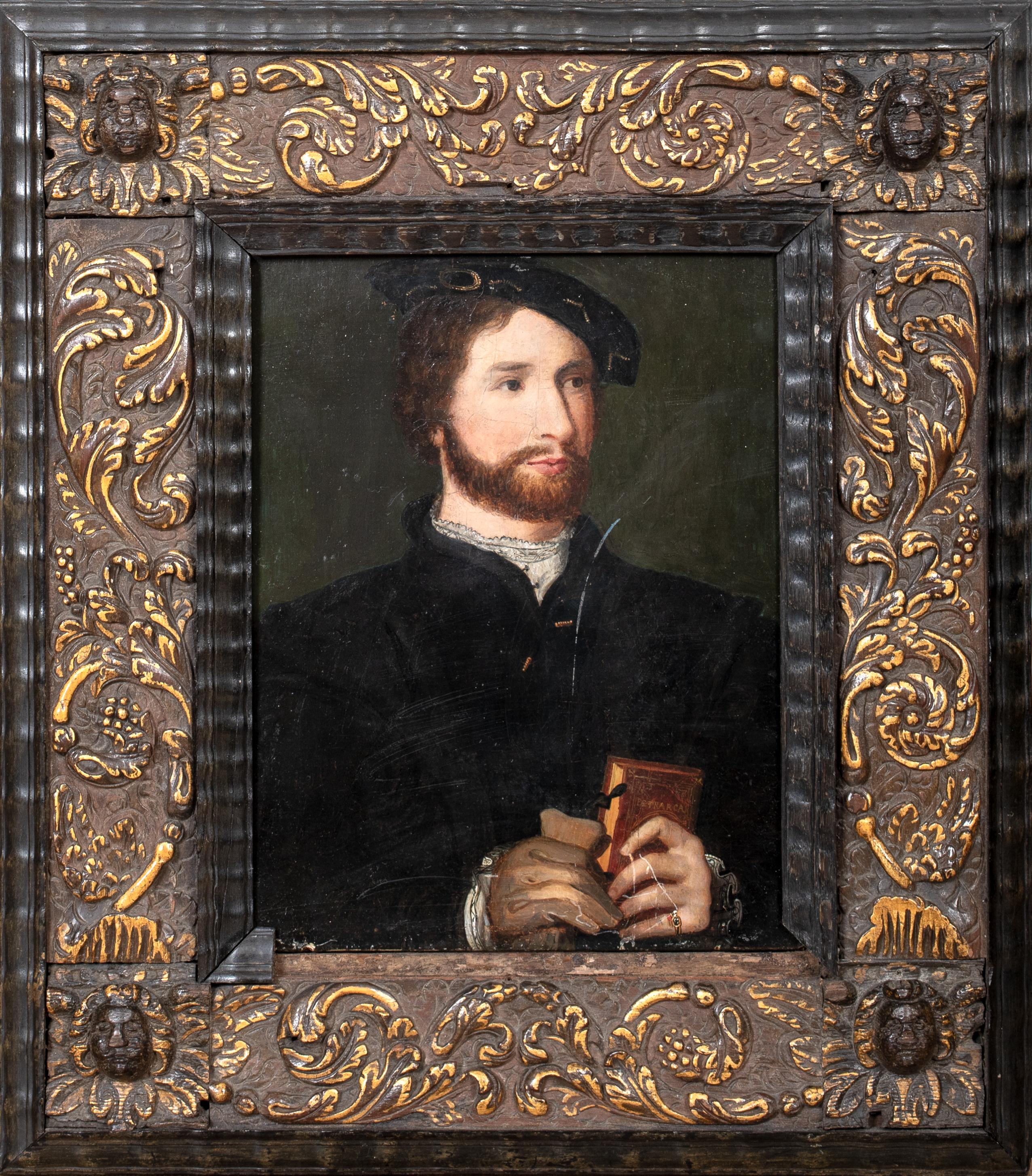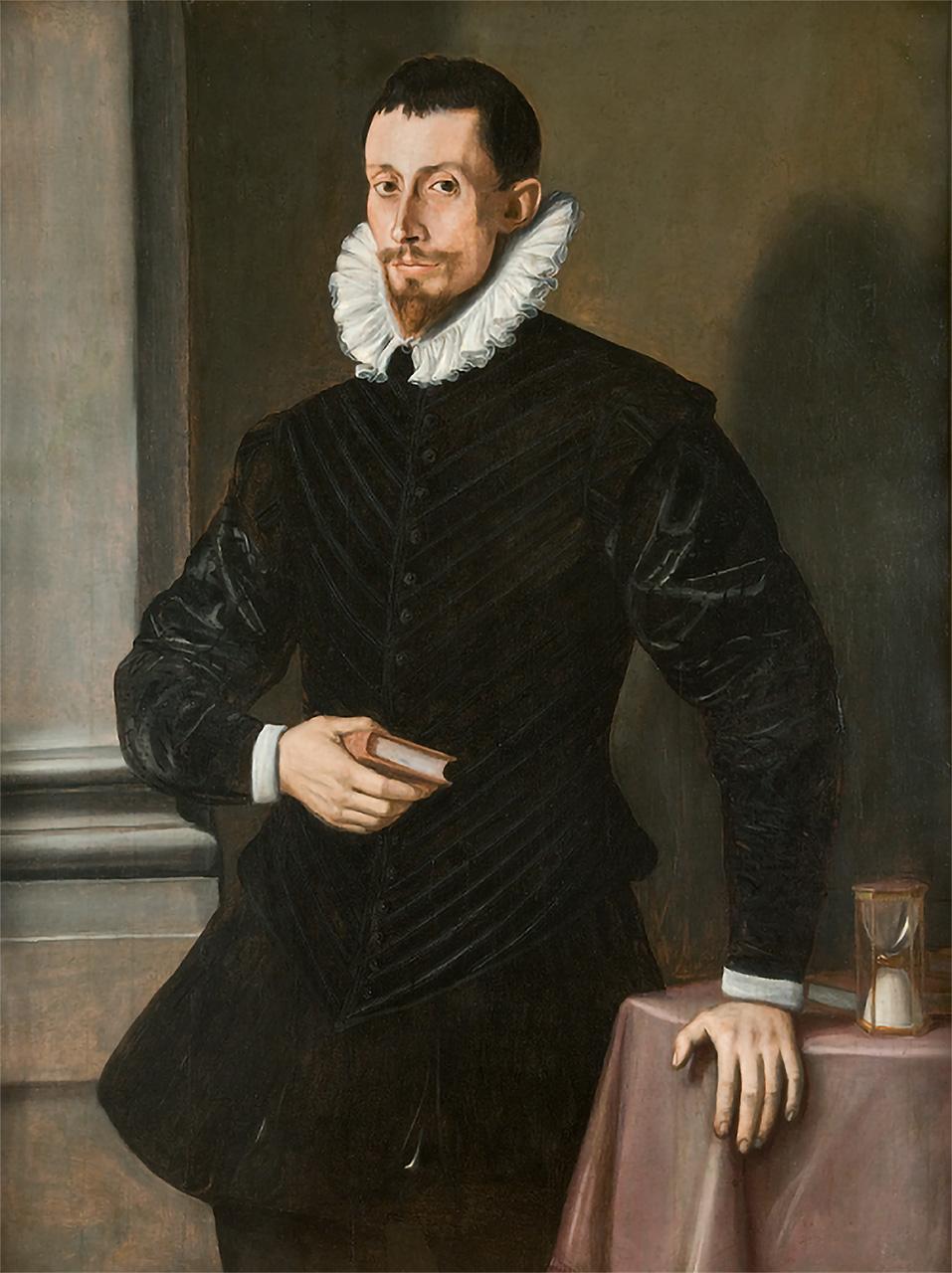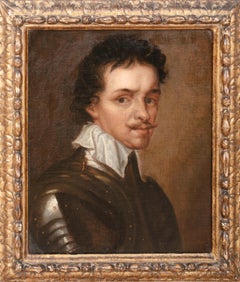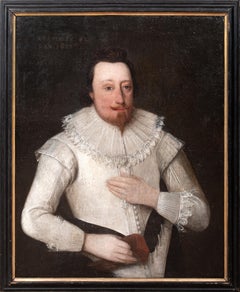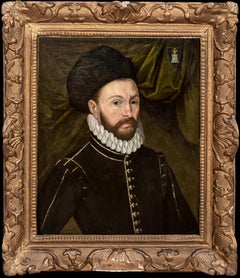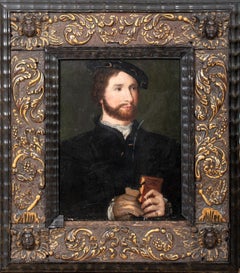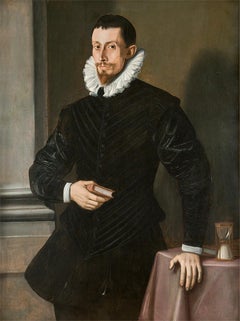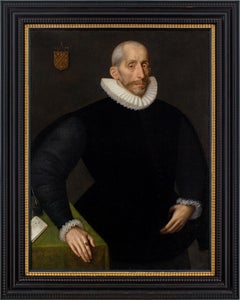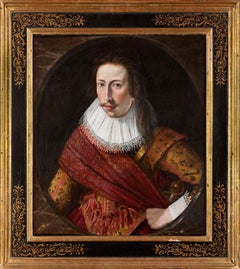Items Similar to Portrait Of Gilbert Talbot 7th Earl of Shrewsbury (1552-1616), 16th Century
Want more images or videos?
Request additional images or videos from the seller
1 of 13
UnknownPortrait Of Gilbert Talbot 7th Earl of Shrewsbury (1552-1616), 16th Century
$16,522.14
$20,652.6820% Off
£12,000
£15,00020% Off
€14,166.76
€17,708.4520% Off
CA$22,725.25
CA$28,406.5620% Off
A$25,277
A$31,596.2420% Off
CHF 13,260.28
CHF 16,575.3420% Off
MX$308,436.77
MX$385,545.9620% Off
NOK 166,433.21
NOK 208,041.5220% Off
SEK 156,843.12
SEK 196,053.9020% Off
DKK 105,748.89
DKK 132,186.1120% Off
About the Item
Portrait Of Gilbert Talbot 7th Earl of Shrewsbury (1552-1616), 16th Century
Circle of George Gower (c.1540–1596)
Huge 16th Century Portrait Of Gilbert Talbot 7th Earl of Shrewsbury, oil on canvas. Large scale three quarter length portrait of Lord Talbot and English Peer and Baron. Standing in court attire wearing a ruff, the order of St George on a Blue Ribbon, a black cape and grey silk doublet and decorated detailing. Inscribed with the sitters name and dates in gold font. Excellent condition, unframed.
Provenance: The Earl of Shrewsbury sale Henry Spencer & Son, Retford
Measurements: 47" x 39" unframed approx
- Dimensions:Height: 47 in (119.38 cm)Width: 39 in (99.06 cm)
- Medium:
- Period:
- Condition:
- Gallery Location:Blackwater, GB
- Reference Number:Seller: 7832951stDibs: LU1577211669032
About the Seller
4.9
Gold Seller
Premium sellers maintaining a 4.3+ rating and 24-hour response times
Established in 2008
1stDibs seller since 2021
294 sales on 1stDibs
Typical response time: 3 hours
- ShippingRetrieving quote...Shipping from: Blackwater, United Kingdom
- Return Policy
Authenticity Guarantee
In the unlikely event there’s an issue with an item’s authenticity, contact us within 1 year for a full refund. DetailsMoney-Back Guarantee
If your item is not as described, is damaged in transit, or does not arrive, contact us within 7 days for a full refund. Details24-Hour Cancellation
You have a 24-hour grace period in which to reconsider your purchase, with no questions asked.Vetted Professional Sellers
Our world-class sellers must adhere to strict standards for service and quality, maintaining the integrity of our listings.Price-Match Guarantee
If you find that a seller listed the same item for a lower price elsewhere, we’ll match it.Trusted Global Delivery
Our best-in-class carrier network provides specialized shipping options worldwide, including custom delivery.More From This Seller
View AllPortrait Thomas Wentworth, 1st Earl of Stafford (1593-1641), 17th Century
Located in Blackwater, GB
Portrait Thomas Wentworth, 1st Earl of Stafford (1593-1641), 17th Century
Circle of Anthonius VAN DYCK (1599-1641)
Fine 17th century English School Old Master portrait of Anthonius...
Category
19th Century Portrait Paintings
Materials
Canvas, Oil
$8,811 Sale Price
20% Off
Portrait Of A Gentleman, identified as Robert Carr, Earl Of Somerset (1587-1645)
Located in Blackwater, GB
Portrait Of A Gentleman, identified as Robert Carr, Earl Of Somerset (1587-1645), 17th Century
English Court Portrait dated 1625
Large 17th Century English Court Portrait, possibly...
Category
17th Century Portrait Paintings
Materials
Canvas, Oil
$6,608 Sale Price
20% Off
Portrait Of Lorenzo Suarez 5th Count Of Corona 16th Century - Antonis Mor
Located in Blackwater, GB
Portrait Of Lorenzo Suarez, 5th Count Of Corona, 16th/17th Century
School of Antonis Mor (1517-1577)
Large Spanish School Old Master portrait of Lorenzo Suarez, Count of Corona, oi...
Category
16th Century Portrait Paintings
Materials
Oil, Canvas
$12,116 Sale Price
20% Off
Portrait Of Henry Howard, Earl of Surrey (1516-1547), 16th Century
Located in Blackwater, GB
Portrait Of Henry Howard, Earl of Surrey (1516-1547), 16th Century
English School Court Portrait
16th century English Court Portrait of Henry Howard, Earl of Surrey, oil on panel. ...
Category
16th Century Portrait Paintings
Materials
Oil, Wood Panel
$5,397 Sale Price
20% Off
Portrait Of Thomas Smythe (1514-1577) School of Hans HOLBEIN (1497-1543)
By Hans Holbein
Located in Blackwater, GB
Portrait Of Thomas Smythe (1514-1577), 16th Century
School of Hans HOLBEIN (1497-1543)
Fine huge 16th Century English Old Master portrait of Sir Thomas...
Category
16th Century Old Masters Portrait Paintings
Materials
Oil
$22,029 Sale Price
20% Off
Portrait Of Richard Jones, 1st Earl Of Ranelagh, 17th Century SIR PETER LELY
By Sir Peter Lely
Located in Blackwater, GB
Portrait Traditionally Identified as Richard Jones, 1st Earl Of Ranelagh, 17th Century
School Of Sir Peter Lely (1618-1680)
Large 17th Century Portrait believed to be Rochard Jones...
Category
17th Century Portrait Paintings
Materials
Oil, Canvas
$9,913 Sale Price
20% Off
You May Also Like
Portrait of William Herbert, 3rd Earl of Pembroke, Early 17th Century Portrait
Located in London, GB
English School, (circa 1600)
Portrait of William Herbert, 3rd Earl of Pembroke
Oil on panel, oval
Image size: 29¼ x 23⅞ inches
Painted wooden frame
Provenance:
176, Collection of Francis Greville, 1st Earl of Warwick.
The Trustees of the Lord Brooks’ Settlement, (removed from Warwick Castle).
Sotheby’s, London, 22nd March 1968, lot 81.
Painted onto wooden panel, this portrait shows a dark haired gentleman in profile sporting an open white shirt. On top of this garments is a richly detailed black cloak, decorated with gold thread and lined with a sumptuous crimson lining. With the red silk inside it’s all very expensive and would fall under sumptuary laws – so this is a nobleman of high degree.
It’s melancholic air conforms to the contemporary popularity of this very human condition, evident in fashionable poetry and music of the period. In comparison to our own modern prejudices, melancholy was associated with creativity in this period.
This portrait appeared in the earliest described list of pictures of Warwick castle dating to 1762. Compiled by collector and antiquary Sir William Musgrave ‘taken from the information of Lord & Lady Warwick’ (Add. MSS, 5726 fol. 3) is described;
‘8. Earl of Essex – an original by Zuccharo – seen in profile with black hair. Holding a black robe across his breast with his right hand.’
As tempting as it is to imagine that this is a portrait of Robert Devereux, the 2nd Earl Essex, we might take this with a pinch of salt. Its identification with this romantic and fatal Elizabethan might well have been an attempt to add romance to Warwick Castle’s walls. It doesn’t correspond all that well with Essex’s portraits around 1600 after his return from Cadiz. Notably, this picture was presumably hung not too far away from the castle’s two portraits of Queen Elizabeth I. The first, and undoubtedly the best, being the exquisite coronation portrait that was sold by Lord Brooke in the late 1970s and now hangs in the National Portrait Gallery. The second, described as being ‘a copy from the original at Ld Hydes’, has yet to resurface.
The portrait eventually ended up being hung in the State Bedroom of Warwick Castle.
Archival documents present one other interesting candidate. The Greville family’s earliest inventory of paintings, made in 1630 at their home Brooke House in Holborn, London, describes five portraits of identified figures. All five belonged to the courtier, politician and poet Sir Fulke Greville (1554-1628), 1st Baron Brooke, and were hung in the ‘Gallerie’ of Brooke House behind yellow curtains. One of them was described as being of ‘Lord of Pembrooke’, which is likely to have been William Herbert (1580-1630), 3rd Earl of Pembroke. William was the eldest son of Greville’s best friend’s sister Mary Sidney, and was brought up in the particularly literary and poetically orientated household which his mother had supported. Notably, the 3rd Earl was one of the figures that Shakespeare’s first folio was dedicated to in 1623.
The melancholic air to the portrait corresponds to William’s own pretensions as a learned and poetic figure. The richness of the robe in the painting, sporting golden thread and a spotted black fabric, is indicative of wealth beyond that of a simple poet or actor. The portrait’s dating to around the year 1600 might have coincided with William’s father death and his own rise to the Pembroke Earldom. This period of his life too was imbued with personal sadness, as an illicit affair with a Mary Fitton had resulted in a pregnancy and eventual banishment by Elizabeth I to Wilton after a short spell in Fleet Prison. His illegitimate son died shortly after being born. Despite being a close follower of the Earl of Essex, William had side-stepped supporting Devereux in the fatal uprising against the Queen and eventually regained favour at the court of the next monarch James I.
His linen shirt is edged with a delicate border of lace and his black cloak is lined on the inside with sumptuous scarlet and richly decorated on the outside with gold braid and a pattern of embroidered black spots.
Despite the richness of his clothes, William Herbert has been presented in a dishevelled state of semi-undress, his shirt unlaced far down his chest with the ties lying limply over his hand, indicating that he is in a state of distracted detachment. It has been suggested that the fashion for melancholy was rooted in an increase in self-consciousness and introspective reflection during the late 16th and early 17th centuries.
In contemporary literature melancholy was said to be caused by a plenitude of the melancholy humor, one of the four vital humors, which were thought to regulate the functions of the body. An abundance of the melancholia humor was associated with a heightened creativity and intellectual ability and hence melancholy was linked to the notion of genius, as reflected in the work of the Oxford scholar Robert Burton, who in his work ‘The Anatomy of Melancholy’, described the Malcontent as ‘of all others [the]… most witty, [who] causeth many times divine ravishment, and a kind of enthusiamus… which stirreth them up to be excellent Philosophers, Poets and Prophets.’ (R. Burton, The Anatomy of Melancholy, London, 1621 in R. Strong, ‘Elizabethan Malady: Melancholy in Elizabethan and Jacobean Portraits’, Apollo, LXXIX, 1964).
Melancholy was viewed as a highly fashionable affliction under Elizabeth I, and her successor James I, and a dejected demeanour was adopted by wealthy young men, often presenting themselves as scholars or despondent lovers, as reflected in the portraiture and literature from this period. Although the sitter in this portrait is, as yet, unidentified, it seems probable that he was a nobleman with literary or artistic ambitions, following in the same vain as such famous figures as the aristocratic poet and dramatist, Edward de Vere...
Category
Early 17th Century Old Masters Portrait Paintings
Materials
Oil, Wood Panel
Early 17th Century by Tiberio Titi Portrait of a Gentleman Oil on panel
Located in Milano, Lombardia
Tiberio Titi (Florence, Italy, 1573 – 1638)
Title: Portrait of a Gentleman
Medium: Oil on panel
Dimensions: Without frame 122 x 91 cm – with frame 162 x 133 x 10 cm
Publications: G...
Category
Early 17th Century Old Masters Portrait Paintings
Materials
Oil, Wood Panel
Gortzius Geldorp, Portrait Of A Member Of The Sani Family, 16th-Century
By Gortzius Geldorp
Located in Cheltenham, GB
This late 16th-century portrait attributed to Flemish artist Gortzius Geldorp (1553-1618) depicts an older member of the Sani family. Produced in 1582 and fully signed, it represents...
Category
16th Century Baroque Portrait Paintings
Materials
Canvas, Oil
Portrait of an Officer, Cornelius Johnson, 17th Century Old Masters
By Cornelius Johnson
Located in London, GB
Circle of Cornelius Johnson
Circa 1620’s
Portrait of a Officer
Oil on canvas
Image size: 28 x 24 inches
Period style hand made frame
Provenance
Private European Estate
This striking portrait dates to around 1620, as you can see from the images of the sash the detail is very high. The sash is decorated with gold thread and would have cost a small fortune at the time. Sashes were originally developed for a military function (making officers more visible for their men during combat), but soon became a primarily male fashion...
Category
Early 17th Century Old Masters Portrait Paintings
Materials
Oil
Portrait of a Gentleman, Doublet & White Ruff, Gloves Inscribed 1624, on panel
By Frans Pourbus the Younger
Located in London, GB
Titan Fine Art presents this exquisite oil on panel portrait depicting a handsome young gentleman in an exuberant black damask doublet. The pose, with one hand holding gloves and the other akimbo, was one that was well-established for gentleman of the upper echelons of society by the time this work was painted. The principle governing portraits at this time was the recording and defining in visual terms of the position of a sitter in society. In addition to brilliant and complex symbols of luxury, they often contained many symbolic elements too; the inclusion of gloves was often used in portraits that celebrated a betrothal as in ancient times gloves were used to seal a marriage contract.
The extraordinary costume of a black shimmering doublet, the brilliant white reticella ruff, and the cuffs edged with lace were immensely costly… this attire proclaims to every onlooker that this is a superior being. The rendering of the reticella lace ruff is exquisite and the artist has recorded the design that runs through the black damask fabric with meticulous attention to detail. The preservation of this black pigment is remarkable considering the age of the work. Black pigments are especially vulnerable to fade and wear over time partly due to environmental condition but also from unprofessional cleaning. This work is an exquisite example from the period.
According to the inscription in the upper right, the gentleman was in his 22nd year of age in 1624. The coat of arms, which is displayed without a crest, may be ‘blazoned’ in the language of heraldry, as: Sable on a Chevron between in chief two Roundels and in base a Billet [or possibly Square] Or three Martlets Sable. In plainer English this means a black (Sable) background, spanned by a gold (Or) chevron, above which are two golden solid circles (Roundels), and below which is a gold rectangle (Billet); on the chevron are three small black birds (Martlets). Martlets are a stylised form of heraldic bird, believed to be based on the swift, which are conventionally drawn with small tufts instead of feet. In Continental Europe it is also conventional for them to be drawn without beaks, as appears to be the case here. The birds in this instance also have a vaguely duck-like appearance.
Five families have been identified with very close armorial bearings to the one in our portrait. They are the (van) Houthem’s (of Brabant), the Prévinaire’s (of Flanders and Holland), and the Proveneer’s (of Liège) and it must be noted that the locations of these families also fit with the painting’s Flemish origins. However the French Grenières’s (of Île-de-France) and the Jallot’s (of Normandy) are the next closest matches and plausible matches, as Frans Pourbus had settled in Paris just a few years before our portrait was painted.
This painting has been assessed by a professional conservator prior to going on sale, and as thus, it can be hung and enjoyed immediately.
Frans Pourbus the Younger...
Category
17th Century Old Masters Portrait Paintings
Materials
Oil, Wood Panel
16th Century by Giovanni Maria Butteri Portrait of Francesco I Oil on Panel
Located in Milano, Lombardia
Giovanni Maria Butteri (Florence, Italy, 1540 - 1606)
Title: Portrait of Francesco I
Medium: Oil on panel
Dimensions: without frame cm. 47.7 x 39 - with frame cm. 55.2 x 46.5
Expertise by Carlo Falciani, art historian
Fairs: The International Biennial of Antiques in Florence 2024 (BIAF, Biennale Internazionale dell’Antiquariato di Firenze)
Publications: From Sacro to Profano, the Giorgio Baratti art collection from Milan, exhibition catalogue curated by Daiva Mitrulevičiūtė, Giovanni Matteo Guidetti and Ileana Maniscalco, (16 February – 27 September 2020), Vilnius, National Museum - Palace of the Grand Dukes of Lithuania, pp. 566-569.
This valuable portrait, by the painter Giovanni Maria Butteri, an exponent of Mannerism and active mainly in Florence, portrays Francesco I de' Medici (1541 - 1587) eldest son of the Grand Duke of Tuscany...
Category
16th Century Old Masters Portrait Paintings
Materials
Panel, Oil
More Ways To Browse
18th Century English Portrait
George Earl
The Black Earl
Painting Oil Earl
Gilbert And George
16th Century Portrait Oil Paintings
Portrait 16th Century Oil
Large 16th Century Oil Paintings
16th Century Unknown Portrait
Gilbert Oil Portrait
Earl Spencer
George Gower
Earl Of Shrewsbury
Portrait Of An Elegant Woman Painting
Portrait Painting Of Princess
Gentleman Oil Portrait
Portrait King Charles
19th Century Children Portraits
